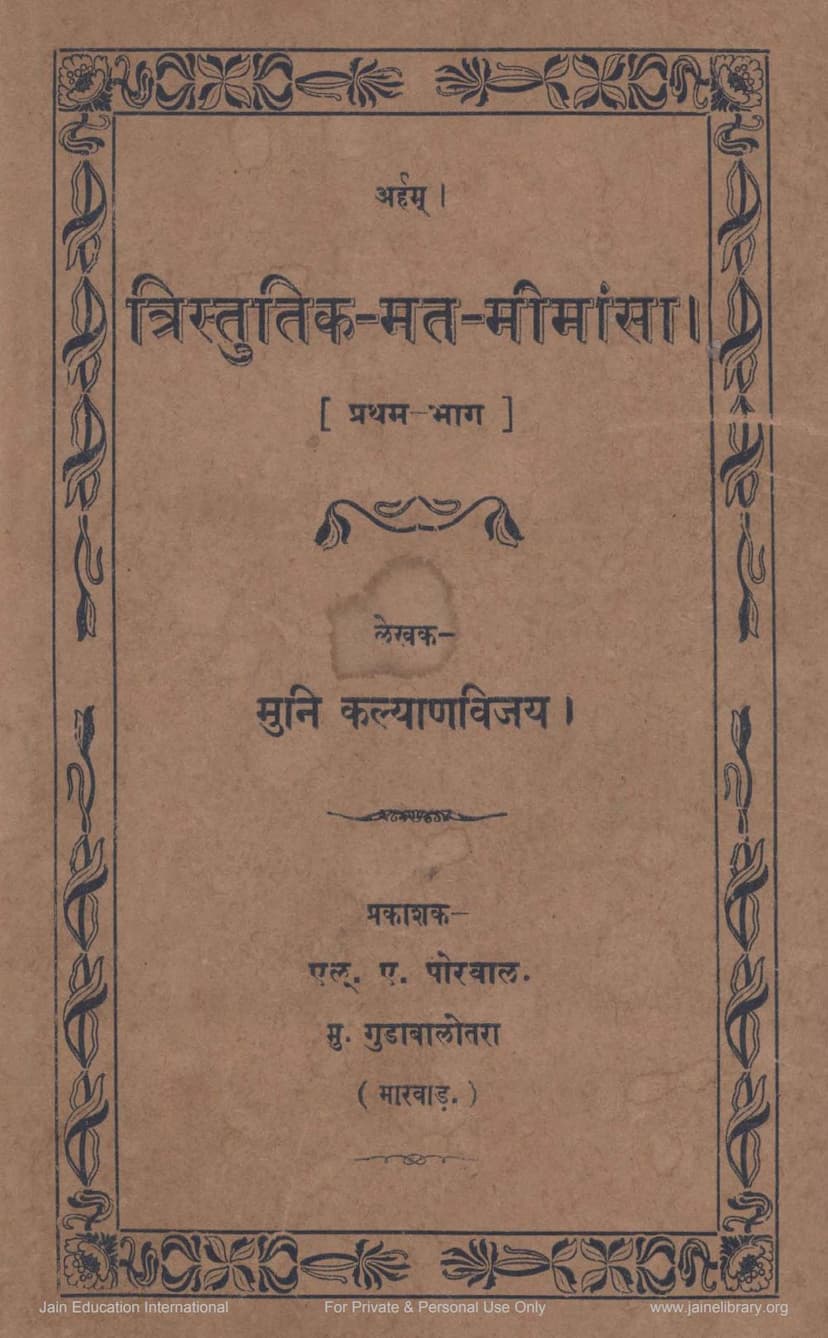Tristutik Mat Mimansa
Added to library: September 2, 2025

Summary
Here's a comprehensive summary in English of the provided Jain text, "Tristutik Mat Mimansa" (First Part) by Muni Kalyanvijay Gani, based on the provided pages:
Book Title: Tristutik Mat Mimansa (त्रिस्तुतिक-मत-मीमांसा) Author: Muni Kalyanvijay (मुनि कल्याणविजय) Publisher: L.A. Porwal (एल्. ए. पोरवाल), Mu. Gudabalotara (मु. गुडाबालोतरा) Publication Date: June 1, 1917 (V.S. 1974, V.S. 2443) First Edition: 500 copies
Overview:
The book "Tristutik Mat Mimansa" is a critical examination and refutation of the "Tristutik" (three-fold praise) sect within Jainism, authored by Muni Kalyanvijay Gani. This first part of the work delves into a contentious debate that arose from an article published in the "Jain Shashan" journal in 1914, which criticized certain actions of Shri Rajendrasuriji, a proponent of the Tristutik sect.
Key Points and Narrative:
-
The Genesis of the Debate: The author, Muni Kalyanvijay, felt compelled to write this book after receiving a response to an earlier article ("Kota Teerth") that had criticized Rajendrasuriji. The response, titled "Samuchit Uttar Dan Patra" (An Appropriate Reply), was written by Munishri Harshvijayji and Teerthvijayji.
-
Misidentification and False Accusations: Muni Kalyanvijay expresses astonishment and amusement that the authors of "Samuchit Uttar Dan Patra" mistakenly identified him as the author of the original "Kota Teerth" article. They consequently leveled numerous unfounded accusations and insults against him in their book.
-
Author's Justification for Response: Despite initially not wanting to engage in public debates, Muni Kalyanvijay felt it necessary to respond due to the baseless attacks and the perceived arrogance and lack of investigation by the opposing authors. He states, "Even though I have not engaged in discussions through articles with the family of Rajendrasuriji to this day, nor have I revealed their serious mistakes and inappropriate actions, yet if they show such cruelty towards me without reason, then I too must pay attention to them."
-
A Noteworthy Interaction: The author recounts a significant encounter in Baghera village where he met with several Tristutik monks, including Teerthvijayji. During their conversation, Teerthvijayji suggested avoiding conflict. However, Muni Kalyanvijay pointed out the need for actual practice to match words. Teerthvijayji then alluded to enduring criticism, which Muni Kalyanvijay countered by stating that while enduring is one thing, allowing slander against revered figures is unacceptable. This conversation highlights the underlying tension and differing perspectives.
-
Reliance on Evidence: Muni Kalyanvijay emphasizes that his arguments and historical claims are not based on hearsay but on evidence derived from letters, manuscripts, and diaries written by Rajendrasuriji himself, his disciples, and lay followers. He presents one such letter as an example, which details Rajendrasuriji's activities and arrangements for translating texts by Brahmin scholars. This highlights his commitment to factual accuracy.
-
Critique of Tristutik Practices and Texts: The core of the book involves a detailed critique of the Tristutik sect's interpretations and practices. The author meticulously analyzes specific points raised by the opposing authors, exposing what he considers to be:
- Historical Inaccuracies: He disputes claims about the lineage of historical figures, the establishment of idols, and historical events, providing his evidence.
- Misinterpretations of Scriptures: Muni Kalyanvijay argues that the Tristutik sect distorts or misinterprets Jain scriptures to support their doctrines, particularly regarding the number of 'thuis' (praises) in rituals and the significance of certain scriptural passages.
- Grammatical and Linguistic Errors: He points out numerous grammatical and linguistic errors in the opposing authors' writings, suggesting a lack of scholarship.
- Questionable Monastic Conduct: The author criticizes the perceived worldliness, attachment to possessions, and departure from true monastic principles allegedly practiced by the Tristutik followers. He also touches upon the contentious issue of initiations and the quality of discipleship within the sect.
- Inconsistent Arguments: He highlights contradictions and inconsistencies in the arguments presented by the Tristutik authors.
-
The "Three-Thui" Doctrine: A significant portion of the critique revolves around the Tristutik sect's insistence on performing religious praises (stutis) in a specific "three-thui" pattern, often in contrast to perceived traditional practices involving four or more praises. Muni Kalyanvijay argues that this emphasis on "three-thui" is a later innovation and not universally supported by ancient Jain scriptures.
-
Defense of "Four-Thui" and other Praises: The author presents scriptural evidence and interpretations to support the validity and historical presence of four-thui and other forms of praise in Jain worship. He argues that these are not necessarily aberrations but can be contextually valid.
-
Rajendrasuriji's Scholarship: A recurring theme is the author's assertion that Rajendrasuriji, despite his influence, lacked genuine scholarship and often made grammatical and scriptural errors. He uses examples from Rajendrasuriji's writings to support this claim.
-
The "Abhidhan Rajendra" Kosh: The author also touches upon the large Jain lexicon, "Abhidhan Rajendra Kosh," suggesting it was compiled by Brahmin scholars under Rajendrasuriji's direction rather than solely by Rajendrasuriji himself. He cites significant expenses associated with its creation.
-
Critique of Tristutik Disciples and Lineage: The book also delves into the succession and alleged lineage of Tristutik leaders, questioning their adherence to traditional Jain principles and highlighting perceived internal conflicts and questionable conduct.
-
Call for Truth and Reason: Ultimately, Muni Kalyanvijay's intention with this book is to present a reasoned and evidence-based critique of the Tristutik sect's doctrines and practices. He appeals to readers to set aside prejudice and consider the truth based on scriptural evidence and historical facts. He acknowledges that some of his language might be strong but attributes it to the provocative nature of the initial attacks.
In essence, "Tristutik Mat Mimansa" is a scholarly and passionate defense of traditional Jain practices against what the author perceives as deviations introduced by the Tristutik sect, particularly under the leadership of Rajendrasuriji. It serves as a historical document reflecting a significant theological debate within Jainism during the early 20th century.